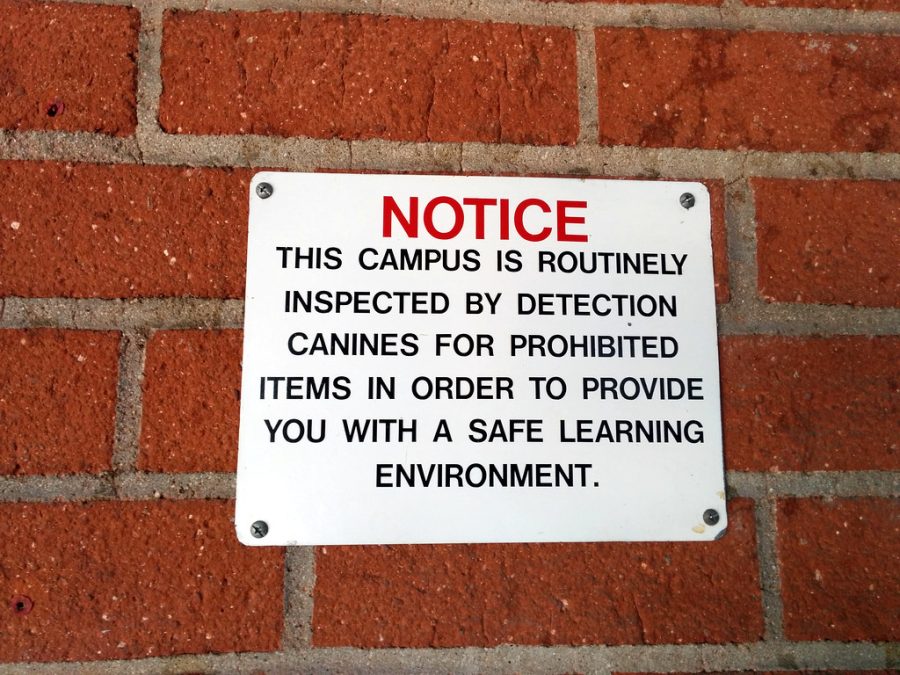Opinion: Local news coverage on the fentanyl crisis is failing
Local news stations in Southern California and nationwide have been largely incompetent in informing viewers on the realities of the fentanyl crisis
A sign notifying students of possible drug inspections at Rosemont Middle School, La Crescenta, CA. Fentanyl overdoses among youth have surged in 2022. Photo courtesy Cory Doctorow/Flickr
For many years, local news in Southern California has been characterized by its unique Hollywood touch, oftentimes leading the news broadcasts to become a spectacle in and of themselves. Local news broadcasts have long been an integral part of the communities they serve, however, it has also been a breeding ground for misleading messaging to take hold and set a narrative about the world their viewers live in. Highlighted with their blatantly sensationalized stories regarding fentanyl, local news stations often have spun stories in a way that leads their viewers down a cautionary path while simultaneously failing to acknowledge how to actually address the issues at hand within local communities.
The recent hysteria surrounding “rainbow fentanyl” – brightly-colored drugs intended to allure children – by local news stations has come across as unserious and misinformed – because it is.
According to a report by NPR, there is no evidence that any of the recent overdose deaths related to the spike in fentanyl usage were related to rainbow fentanyl obtained while trick-or-treating.
Long before fentanyl has become an issue, local news has pushed a narrative to its viewers to be cautious of drug-laced candy being given to trick-or-treaters on Halloween. Many who have gone trick-or-treating may recall having conversations with their parents warning them to be aware of drug-laced candy and to check if any of the candy wrappers were opened or tampered with. While it is absolutely valid for parents to be cautious of what their children consume, at the end of the day, random incidents of a trick-or-treater eating drug-laced candy have never occurred and these stories paint a picture of the fentanyl crisis that is far from the truth.
In October, many local news broadcasts ran segments covering the looming dangers of rainbow fentanyl, specifically warning parents to remain vigilant in checking their children’s Halloween candies for the pills. This is despite the overwhelming evidence that no such incident of a child mistakenly eating drug-laced Halloween candy has ever occurred.
One segment aired on ABC 7 Los Angeles on Oct. 4 opened with the words, “A parent’s worst nightmare,” while also making sure to mention, “The drug that looks like candy is especially concerning with Halloween approaching.”
There is more to these segments than just simply misinformation though. Using clips of kids trick-or-treating and releasing the segments in the weeks leading up to Halloween, the messaging of the stories combined with the warnings from the police themselves could lead to viewers becoming fearful of what is otherwise a false flag.
Local news evades the consequences of publishing these misleading stories by hiding behind their facades of credibility, but it is what is unsaid that is also revealing. While the segments will present interviews with police officers to viewers as credible and bulletproof information, they reduce any real analysis of data surrounding children overdosing from Halloween candy laced with drugs to a footnote of the story or will be left out altogether.
Another fentanyl-related story published by FOX 35 Orlando on Dec. 14 shows another side to the dangers of incompetent local news reporting. In the story, a video showed a Floridian police officer who supposedly overdosed after being exposed to fentanyl at the scene of a crime. However, according to various experts, the officer showed no actual overdose symptoms and more accurately displayed the symptoms of a panic attack.
This reporting on an officer’s alleged overdose fell very short of adequate. For one, the reporting overlooked simple fact checks on the matter, such as any toxicology reports of the officer involved that would indicate the officer did indeed have fentanyl in their system, instead, FOX 35 Orlando only took the word of the city’s police chief who spoke to them at face value. Additionally, they failed to consider any input from those knowledgeable about fentanyl overdoses, such as EMTs, who come in contact with fentanyl and fentanyl users on a daily basis and have the experience and knowledge to identify and treat fentanyl overdoses.
The result of this failure in reporting could be very damaging. The impression viewers may get is that this may happen to them if they were to come into contact with fentanyl, an impression which could lead people to shy away from treating somebody who is overdosing for the fear of overdosing themselves, ultimately leading to more deaths.
As is the case, fentanyl overdoses among youth in Los Angeles County have surged this year. It is abundantly clear that this is a serious issue that deserves a full and concerted response, such as more accessible drug rehabilitation and treatment programs, yet these rainbow fentanyl segments take the conversation away from time that otherwise could be spent educating the public on how to treat or prevent overdoses and possibly save lives as a result.



